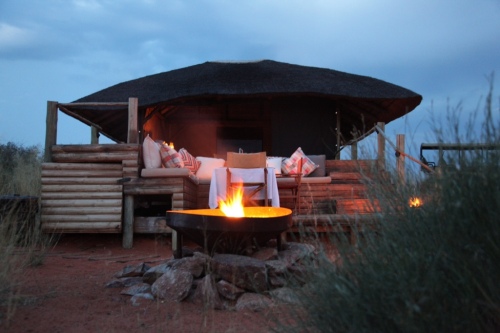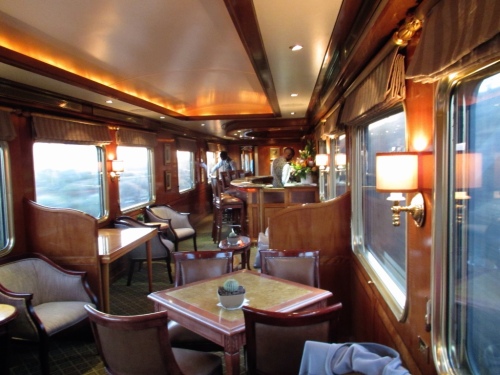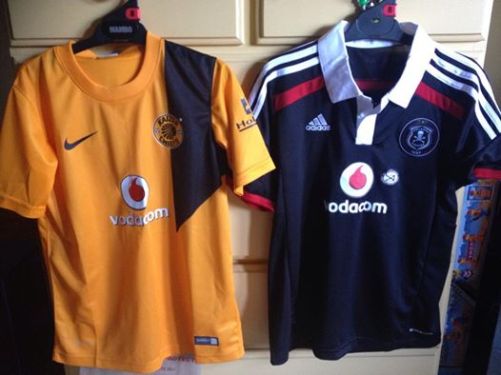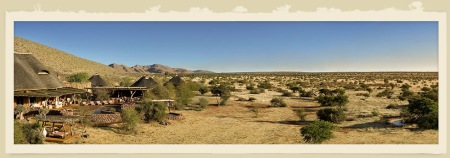When we were preparing and packing for our trip to South Africa I looked online for suggestions of what and how much to pack for us, two adults and two kids.
Our trip included:
- 2 x 12-14 hour flights to South Africa and back
- 2 nights in a hotel near Johannesburg (Maropeng) and day trips to the Cradle of Humankind and a Cheetah Research Centre
- 1 night and 2 days on the luxury Blue Train, including a dinner requiring formal wear
- 5 nights in Cape Town with day trips around Cape Town, to Table Mountain, and the Cape Peninsula
- 4 nights on safari at Tswalu Kalahari with early morning and afternoon/evening game drives
The weather was predicted to be mid to high twenties (Celsius) during the day and colder in the mornings, evenings and overnight. It certainly was cooler in Cape Town than in both Johannesburg/Maropeng and Tswalu. It was especially hot during the day at Tswalu. But it was quite cold on our early morning game drives.
On many safaris, including ours, you are restricted in the amount of luggage you can take and you need to pack in soft sided bags (not wheely bags). For Tswalu we were restricted to 12 kg each of checked luggage and 6 kg each of hand luggage. So just 18 kg each. I also read online advice about colours and fabrics for safari clothes (not black, not navy, not white, not red!).
Also of relevance, in Cape Town (at the Cape Grace Hotel) we could send dirty laundry to the cleaners and have it charged to our room; at Tswalu our laundry was free. Several safari lodges include free laundry, so it is worth checking.
For families planning a safari, here’s how we packed and what we packed for this trip. Perhaps it will help you.
Luggage
For checked luggage, we used two North Face Large Base Camp duffel bags (90 L each), packing 1 adult and 1 kid’s clothes per bag. We also took a Samsonite suit bag, packing our “good clothes” for the Blue Train’s formal dinner, as well as overflow items.
For carry on luggage, my husband and I each carried a Crumpler Backpack (The Dry Red No 5, 20 L) for camera gear, electronic devices, stuff for the plane, wallets etc. And our two kids each carried a small backpack for a few books, toys, colouring pencils etc
In addition, we packed a light weight Herschel Packable Duffel Bag (30 L). This cunning bag folds up into a small package and then unfolds into a good-sized bag. We used this on the Blue Train to separate out items from our large duffel bags we wanted in our cabins (the rest of our luggage was stored in a luggage carriage). We also used it to carry home souvenirs we needed to declare to Customs.
Finally, I packed an empty Crumpler iPad bag in my luggage to use on day trips as my hand bag. 
When fully packed before leaving, our luggage weighed about 62 kg, 10 kg less than our weight limit. And we were well under our 48 kg checked luggage and 24 kg carry on luggage limits. This is partly because our kids’ back packs weighed very little. I recommend limiting toys and other items from home since kids will pick up souvenirs and other items on their travels. So start light!
Packing Lists
For both adults and kids we used a rule of thumb of 4-5 days of clothing, planning to do laundry when we reached Cape Town and then at Tswalu. We ended up doing a large load when we arrived in Cape Town and another small load just before we left for Tswalu. Then we did another large load our first day at Tswalu and small daily extras (because it was included in the cost of our room).
Here’s what we packed for our kids …
- 1 pair of sneakers (Louisa, 5) or 1 pair of walking shoes (Oliver, 9); sneakers were fine for the game drives we went on, which involved minimal bush walking
- 1 pair of pool side shoes (sandals for Louisa, Crocs for Oliver)
- 1 pair of “good” shoes for our formal dinner and nice outings (silver flats for Louisa, fancy sneakers for Oliver)
- A rain jacket (which we didn’t in fact use — no rain on our trip — but still worth packing).
- A warm fleece jacket/jumper for planes, cooler mornings, early game drives
- 2 short-sleeved t-shirts each, 2 long-sleeved t-shirts each, plus an extra long-sleeved t-shirt to wear on the plane; we found nice merino long-sleeved shirts for Oliver at Pumpkin Patch and nice long and short-sleeved easy care shirts for both at Kathmandu
- For Oliver’s pants, 2 pairs of Kathmandu light weight pants (with zip off legs converting them to shorts), a pair of shorts, a pair of swimming “boardies”. We also took a pair of track suit pants but he didn’t use them
- For Louisa’s pants, 2 long leggings (1 heavier weight, 1 light weight), 2 3/4 leggings (we only needed 1 pair), a pair of shorts
- 4 pairs of underpants plus 1 extra for the plane; 2 singlets each; 4 pairs of socks plus 1 extra for the plane
- A pair of pyjamas
- Swimmers and goggles
- A broad-brimmed hat each and a cap each
- Toiletries (especially sunscreen for game drives) and a selection of medicine (we used panadol, neurofen, cortisol cream for various ailments while away)
- For the formal dinner and other nice outings, for Oliver we took a pair of navy Chinos, collared shirt and blazer. For those in Sydney, I found the pants and shirt on sale at Birkinhead Point Factory Outlet Centre. For Louisa we took two sleeveless dresses from Pumpkin Patch (because she and I liked different ones!) and a light long-sleeved cardigan
Most of Oliver’s clothes were in neutral colours: grey, green, blue. Most of Louisa’s clothes were in purple, lilac, green. We didn’t especially look for “safari” clothes so everything could be worn again back in Sydney.
My husband and I followed the same pattern:
- 1 pair of sneakers (for me) or 1 pair of walking shoes (for Peter)
- 1 pair of pool side shoes (sandals for me, casual shoes for Oliver)
- 1 pair of “good” shoes for our formal dinner and nice outings (silver wedges for me, leather shoes for Peter)
- A rain jacket; we both took Kathmandu packable rain jackets, which fold up into a small zipped pocket
- A warm fleece jacket for planes, cooler mornings, early game drives; we found these on sale at Kathmandu
- I took 2 long-sleeved merino t-shirts and a vest for the plane and early morning drives. I also took 3-4 light kaftan tops layered over singlets for everyday wear
- Peter took 2 short-sleeved shirts and 2 long-sleeved shirts like the kids, plus an extra shirt for the plane. Again, Kathmandu was a good source for easy care shirts
- For pants, I took 2 pairs of 3/4 pants, 1 pair of long cotton pants, and 1 pair of light weight jeans
- Peter took 2 pairs of Kathmandu light weight pants with zip off legs, an extra pair of shorts (which he didn’t use), and a pair of jeans
- We took a similar number of pairs of underwear and socks as the kids
- Pyjamas
- Swimmers
- A broad-brimmed hat or cap each
- Toiletries, medicine
- For the formal dinner and other nice outings, I took a pair of navy slacks, two fancier tops, and a soft jacket. I didn’t need the second top. Peter took a nice pair of pants, formal shirt, jacket and tie
- I also took two extra warmer layers, but I didn’t really need them. I dressed in them on a few cold mornings but changed after breakfast. They were too warm. There was only one morning at Tswalu that I might have worn them but didn’t. So I could have left these at home
Most of my clothes were navy, grey and cream; colours I often wear. Dark colours such as black or navy are not recommended in summer in Africa because they attract the heat or flies, but I had no problem with them in spring. Peter’s clothes were like Oliver’s: grey, green, blue. Again, we didn’t want to buy special “safari” wear looking clothes, which we might not get use out of back in the city.
We easily had enough clothes as well as met our luggage limits. In addition to the items above we took chargers and cables for our electronic devices (including a plug for Africa and a power board), a large Canon 5D Camera plus lenses for good quality animal shots, a small point-and-shoot camera, and a small video camera for the kids to use.
I was tempted to buy into the whole safari look, but mostly we took and packed our normal clothes with just a few additions: Oliver and Peter’s pants with zip off legs, which they will reuse for Scouts; our rain jackets; our new fleece jackets; and some extra easy care shirts.
At Tswalu, a number of the other guests were wearing safari kit from top to toe, but many were in the midst of a series of safari stays spanning many weeks. For just 5 days, our selection of clothes worked well (with just a few items we should have left at home). The most important thing is to pack light if you can and use laundry facilities at your accommodation.
I hope this list helps in planning your African adventure. Please add any other suggestions in the comments below.
Cheerio Amanda












































































